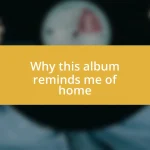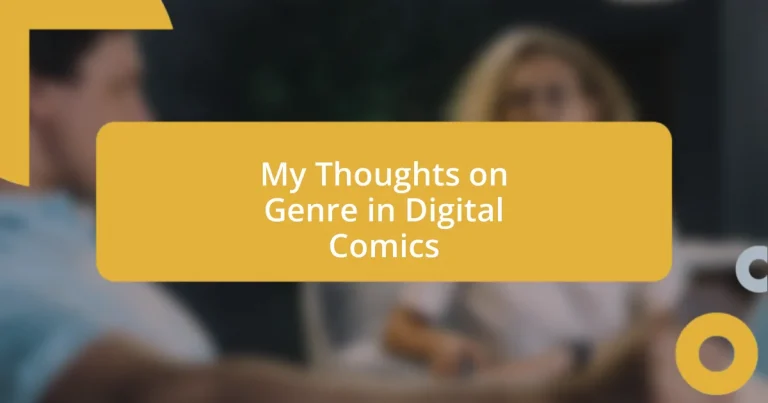Key takeaways:
- Genres in digital comics shape readers’ expectations and emotional experiences, offering a framework for navigation and connection.
- Genre blending creates unique narratives by combining elements from different genres, enhancing storytelling and broadening themes.
- To create genre-specific comics, immerse yourself in conventions, develop relatable characters, and experiment with visual storytelling techniques.
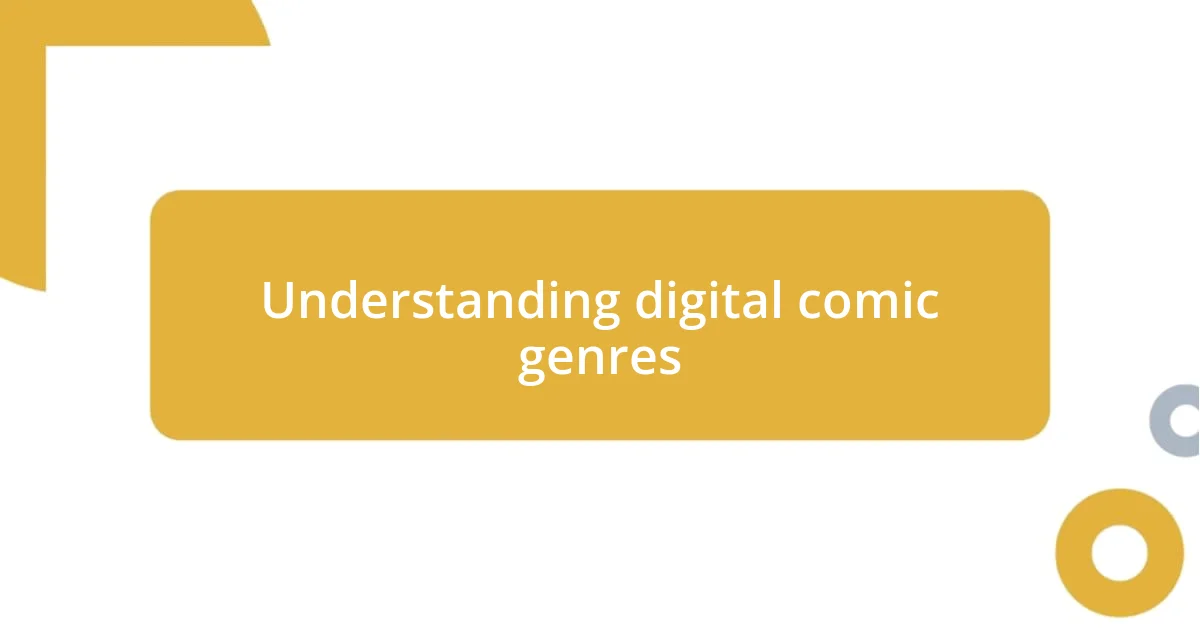
Understanding digital comic genres
Understanding digital comic genres can feel overwhelming at first, especially with the sheer variety available today. I remember when I first discovered webcomics; I was instantly captivated by how each genre offered something unique. It’s fascinating to think about how genres like fantasy and science fiction can transport us to entirely different worlds, something that can be both exciting and comforting.
Delving deeper into these genres, I often wonder how certain themes resonate more with some readers than others. For instance, in my exploration of horror comics, I noticed they evoke a different emotional reaction compared to slice-of-life stories. The adrenaline rush a good horror comic can deliver is exhilarating, yet the warmth of a heartfelt narrative often leaves me with a lasting sense of joy. Does anyone else find that certain genres feel like a perfect fit for their moods?
What I find particularly special about digital comics is how they can blend elements from different genres, creating something entirely new. I think about the hybrid genres emerging today, like sci-fi romance or fantasy thriller, and how they push the boundaries of storytelling. This fusion invites readers to experience narratives that reflect the complexities of real life, broadening our perspectives and deepening our engagement. Have you explored any genre mashups that left you thinking long after you closed the comic?

Importance of genre in storytelling
The importance of genre in storytelling cannot be overstated. Genres provide a framework that helps both creators and readers navigate narratives with clarity. When I pick up a digital comic, I instinctively gravitate toward genres that resonate with my current mood or interests. Whether it’s the thrill of a superhero tale or the intrigue of a mystery, genres set the stage for my emotional journey and enhance my overall reading experience.
- Genres shape expectations, guiding us on what to anticipate from a story.
- They create connections, helping us find communities of like-minded readers who share our tastes.
- Genres often explore universal themes, making complex emotions and situations more relatable.
- They inspire creativity, allowing authors to experiment and innovate within familiar boundaries.
- A strong genre identity can help a comic book more easily find its audience and gain traction in a crowded marketplace.
Reflecting on my experiences, I’ve noticed that my connection to certain genres has often mirrored my life stages. For instance, during a challenging time, I found solace in uplifting slice-of-life stories that offered a sense of hope. Conversely, when seeking an adrenaline rush, I turned to fast-paced action comics that kept my heart racing. This fluidity of genre illustrates how storytelling acts as a mirror to our own experiences, making genre an essential element in crafting compelling narratives.

Popular genres in digital comics
When exploring popular genres in digital comics, I often find myself drawn to the vibrant world of fantasy. It’s interesting how these stories allow for limitless possibilities—think of epic quests and magical realms. I recall a time when I stumbled upon a fantasy webcomic that completely shifted my perspective on storytelling, weaving together elements of adventure and deep character development that felt both relatable and enchanting.
In contrast, I’ve also developed a fondness for the superhero genre, which resonates with my need for escapism. Superhero comics often embody ideals of justice and valor, making it thrilling to see how characters confront their nemeses. I remember reading a series where the hero struggled with their own personal demons while saving the day—this duality made me appreciate the writing even more.
There’s also a growing popularity of slice-of-life comics, which capture everyday moments with a touch of humor or nostalgia. These stories can evoke a sense of familiarity that many readers find comforting. Reflecting back on my own experiences, I once found myself laughing out loud at a slice-of-life comic depicting the quirks of everyday life during my university days. There’s something wonderfully engaging about how these simple narratives can resonate deeply with our shared human experiences.
| Genre | Description |
|---|---|
| Fantasy | Stories filled with magic, mythical creatures, and epic quests. |
| Superhero | Comics focused on heroic figures, moral challenges, and dramatic clashes. |
| Slice-of-Life | Narratives that capture everyday experiences and emotional nuances. |
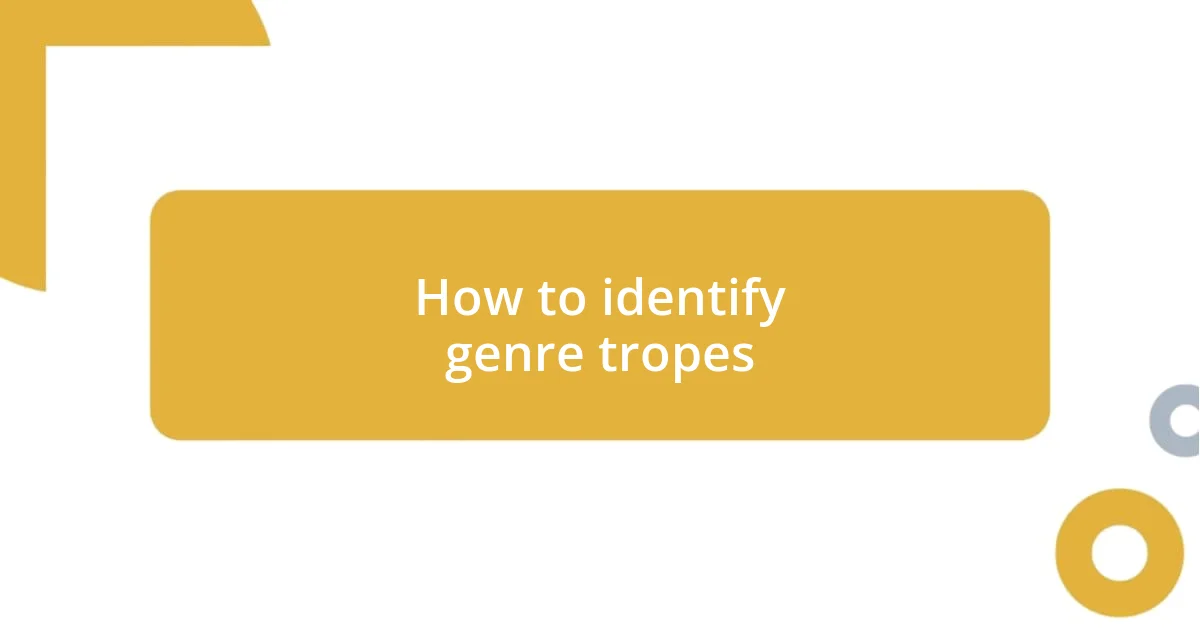
How to identify genre tropes
To identify genre tropes, I often start by recognizing the common themes and character types that characterize a genre. For example, in horror comics, there’s typically an element of fear or dread, often amplified by the presence of a haunting antagonist. Can you recall a moment when you felt that spine-chilling suspense? Those moments are what make horror so visceral.
Diving deeper, I look for recurring story structures that signal a particular genre. Take a superhero comic, for instance; they usually involve an origin story, a significant conflict, and a resolution where good triumphs over evil. Reflecting on my own experience, I once read a comic where the hero faced not only a formidable villain but also their own self-doubt. That internal clash added a refreshing twist to the expected tropes.
Lastly, I pay attention to the visual style and tone of the artwork. In fantasy comics, you might notice vibrant colors and imaginative landscapes, while noir comics often use shadowy, muted tones to evoke mystery and intrigue. I remember flipping through a fantasy comic bursting with color, feeling as though I was stepping into a different world. It made me wonder: how does the art influence your connection to the genre? Each visual cue helps solidify the genre’s identity and enhances the reading experience.
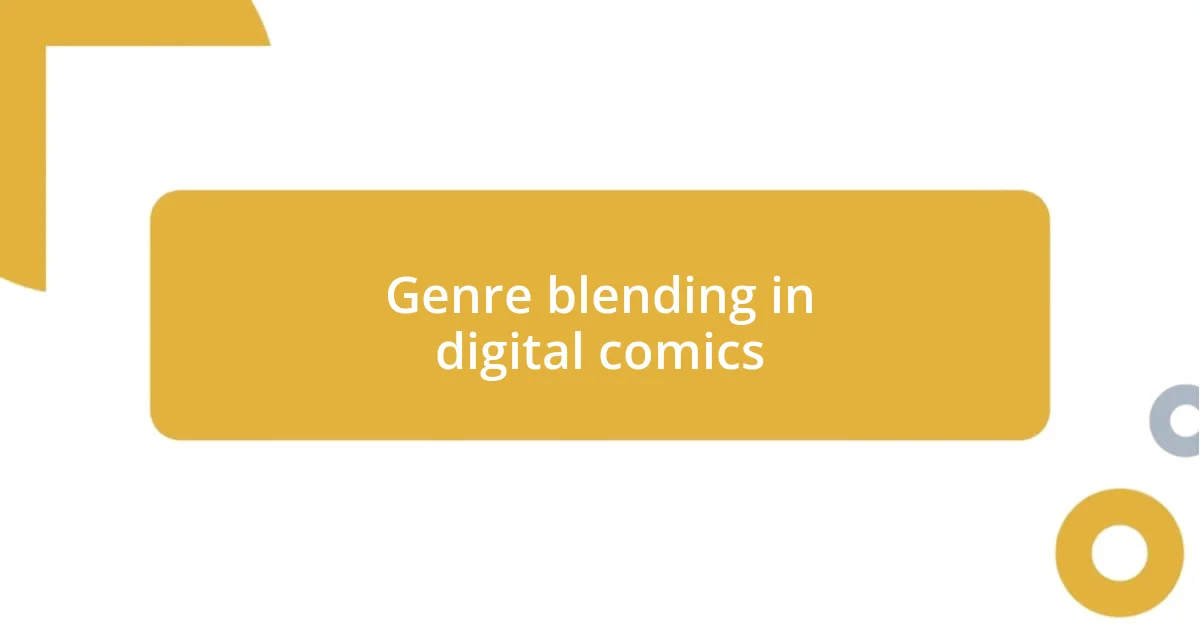
Genre blending in digital comics
When I delve into the realm of genre blending in digital comics, it fascinates me how seamlessly different genres intertwine. I recently came across a comic that masterfully mixed science fiction and romance, set in a futuristic world where love transcends time. It got me thinking—how does the emotional depth of romance enhance the exhilarating backdrop of space travel? That combination drew me in, making the possibilities of love in such an expansive universe feel both profound and relatable.
I find that the blend of genres not only broadens narrative horizons but also creates unique reading experiences. For example, I recall a graphic novel that fused elements of horror and humor. It’s not every day you laugh while a character narrowly escapes a zombie apocalypse! This unconventional mixture made me appreciate how blending genres can elevate storytelling and provide a refreshing escape from traditional expectations. It showcases the creativity and innovation bubbling in the digital comic sphere.
Genre blending also allows creators to explore complex themes in more relatable ways. I remember reading a digital comic that combined elements of historical fiction and fantasy, placing characters in real historical events while introducing fantastical elements like mythical creatures. This interplay not only entertained me but also made me reflect on how our understanding of history can be peppered with imagination and wonder. Don’t you think that this fusion offers a richer context for exploring universal themes? It’s a powerful reminder that genre boundaries are merely guidelines, not limitations.
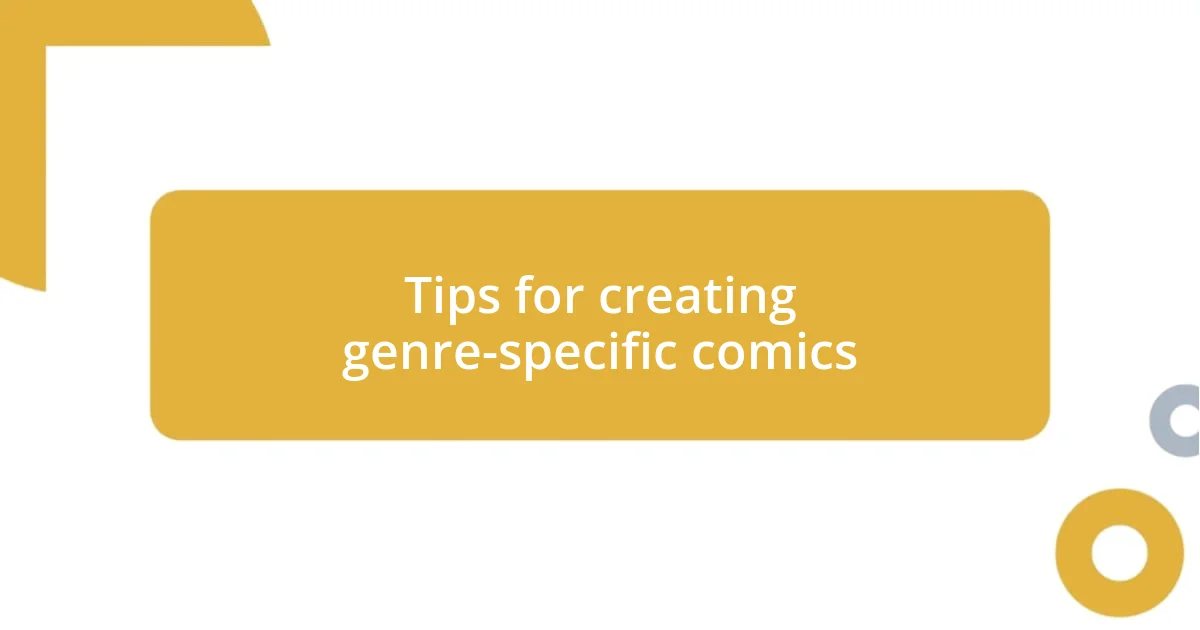
Tips for creating genre-specific comics
To create compelling genre-specific comics, I believe it’s crucial to immerse yourself in the genre’s conventions. Spend time reading various examples within that genre, absorbing the narrative styles, character roles, and visual cues. I remember when I tackled my first horror comic; I binge-read classics like “The Walking Dead” to understand the pacing and tension before putting pen to paper. How does studying others shape your own creative process?
Another tip is to develop strong characters that resonate with the genre’s tropes. For instance, in a sci-fi comic, consider crafting a complex protagonist who grapples with their humanity while facing ethical dilemmas posed by advanced technology. I once sketched a character who was a brilliant scientist but haunted by the consequences of her inventions. It was fascinating to explore how that internal struggle added layers to her interactions and challenges. What aspects of your characters drive the story forward?
Finally, don’t shy away from experimenting with visual storytelling techniques specific to the genre. In noir comics, for example, play with contrast and shadow to create mood and suspense. My experience with a black-and-white comic taught me how impactful visual choices can be in setting the tone. Each panel felt like unearthing secrets as the reader navigated through dimly lit alleys. How do you think visual choices shape a reader’s expectations of the genre?

